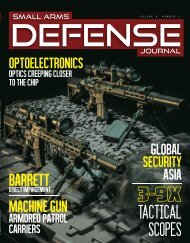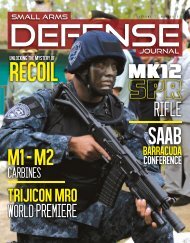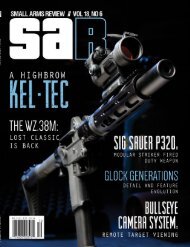Create successful ePaper yourself
Turn your PDF publications into a flip-book with our unique Google optimized e-Paper software.
DPMS GII SASS.308 Win. AR Rifle<br />
and other types of supported fire if needed.<br />
Some of the precision tactical rifles coming<br />
on line today reflect more of target shooting<br />
heritage than tactical weighing over 16<br />
pounds. The GII SASS’s 10 pound weight<br />
translates into a rifle that can be carried<br />
afield without fatiguing the marksman and<br />
is easier to adapt to non-standard firing<br />
positions even offhand if needed. The 18-<br />
inch medium profile barrel is a solid compromise<br />
balancing weight, performance,<br />
and field handling for the tactical marksman.<br />
The GII SASS had no problems with<br />
shifting points of aim even when firing a<br />
full magazine of twenty aimed rounds in<br />
relatively rapid fashion.<br />
A Schmidt & Bender (S&B) 5-20x50<br />
PM II Ultra Short was mounted on the GII<br />
SASS via a Recknagel quick release mount.<br />
The S&B had a Tremor 2 reticle. Further<br />
tactical modification of the GII SASS into a<br />
lowlight/dark role is satisfied by mounting<br />
an American Technologies Network ATN<br />
PS22 Night Vision device in front of the<br />
Schmidt & Bender scope. This multi-use<br />
ability keeps day scope constantly zeroed,<br />
yet allows for quick adaptation during a<br />
night mission. This eliminates the need<br />
for a separate dedicated weapon system<br />
exclusive to night vision tasks or having to<br />
constantly remove day optics from a rifle<br />
and replacing with a NVD. The PM II Ultra<br />
Short design had just this application in<br />
mind with its design. The ATN PS22 serves<br />
as a force multiplier when employed on the<br />
GII SASS. The forend also has side rails for<br />
mounting IR illuminators used in conjunction<br />
with the NVD device or intense<br />
tactical white lights if NV is not used. The<br />
GII SASS reflects modern trends of utilizing<br />
night vision with night vision devices<br />
easily mounted.<br />
Various .308 Win. loadings from<br />
Black Hills Ammunition, Federal, Winchester<br />
and Hornady provided the basis<br />
of accuracy tests. The Black Hills Match<br />
loads tested consisted of 168 grain Match<br />
bullets. The Federal chambering was the<br />
venerable 168 grain Match load. 168 grain<br />
TAP from Hornady and 168 grain Match<br />
from Winchester was also tested. The GII<br />
SASS’s 18-inch barrel with the 168 grain<br />
loads clocked 2,550 feet per second. As<br />
to be expected with quality ammunition,<br />
velocity figures within the different<br />
loads deviated very little from round to<br />
round. This is critical for predicable long<br />
range accuracy.<br />
The GII SASS shot all the premium<br />
168 grain loads tested into 1 MOA or better<br />
at 100 yards. Many will scoff at this as typical<br />
gun writer fluff. Obviously, the best ammunition<br />
brands and loads where utilized.<br />
Black Hills Ammunition, Federal, Winchester,<br />
and Hornady are industry leaders,<br />
which is what this type of rifle deserves<br />
to wring out its full potential. The testing<br />
was done off a bench supported by Harris<br />
bipod and Champion shooting bags. The<br />
Federal 168 grain Match, Winchester 168<br />
grain Match, and BHA 168 grain Match<br />
produced the best 100 yard average with<br />
all producing slightly over 5/8 inch averages.<br />
The accuracy figures are based on firing<br />
3 three-round groups and averaging group<br />
sizes. Another sign of an accurate, dependable<br />
rifle is how cold bore zeros compare<br />
over time and if the point of aim shifts<br />
after a few rounds heat up the barrel. The<br />
DPMS GII SASS showed no shifts in point<br />
of aim and cold bore zeros produced fine<br />
groups when overlaid together.<br />
Not much time was spent at the 100<br />
yard range. After verifying innate accuracy<br />
from the bench, field tests were performed<br />
at Echo Valley Training Center (EVTC).<br />
Echo Valley Training Center is properly<br />
set-up to handle extensive test firing of a<br />
precision tactical rifle like the GII SASS. In<br />
conjunction with the individual training<br />
bays, EVTC features multi-stepped target<br />
berms that are strewn with reactive steel<br />
targets, fluid drained automobiles, and<br />
moving targets at ranges varying from<br />
150 yards out to 350 yards. Echo Valley<br />
Training Center is further enhanced by<br />
the existence of prepared firing positions.<br />
This allows for more realistic prone and<br />
“dug-in” trench-style firing points consisting<br />
of concrete culverts turned on end<br />
and buried. These firing positions and target<br />
arrangements are ideal for all types of<br />
SADEFENSEJOURNAL.COM 37









